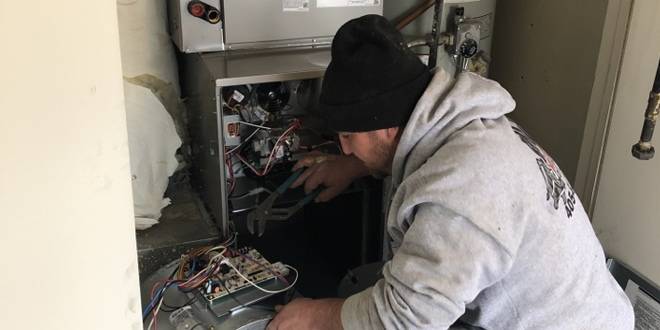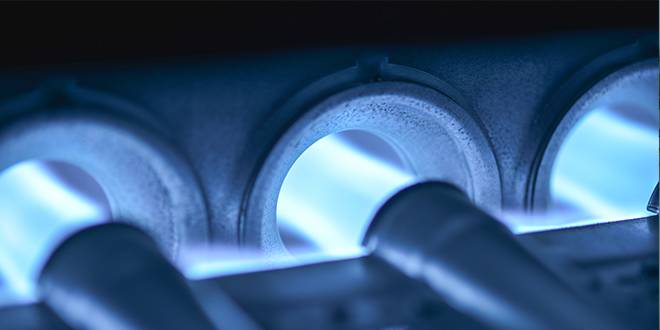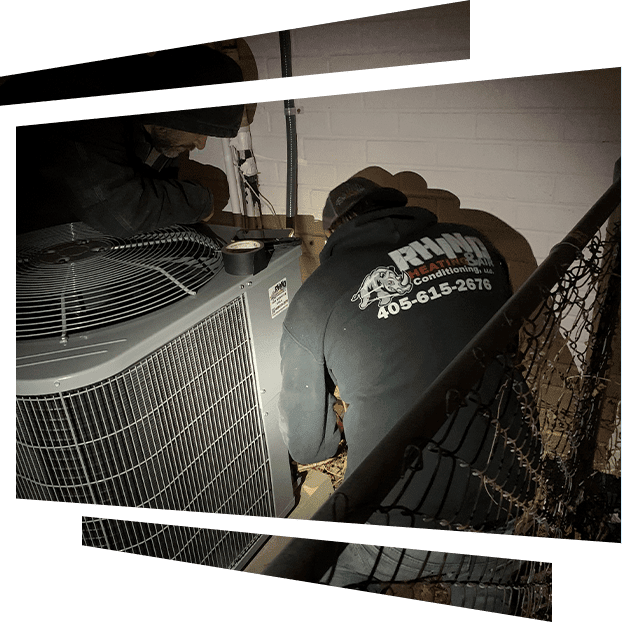
In the chilly winters of Oklahoma City, your furnace becomes your best friend. But what happens when it develops a cracked heat exchanger? Join us as we delve into the world of furnaces, exploring what a cracked heat exchanger is and why it’s crucial to address this issue promptly.
Understanding the Heat Exchanger and Its Role
What is a Heat Exchanger?
A heat exchanger is a vital component of a furnace responsible for transferring heat from the combustion chamber to the air that circulates throughout your home or business. It consists of a series of tubes or coils that are heated by the combustion process. As air passes over these heated surfaces, it absorbs the heat, which is then distributed throughout the building via the ductwork.
How Does a Heat Exchanger Work?
Heat Transfer: The combustion process generates heat, which is absorbed by the heat exchanger’s metal surfaces.
Air Circulation: As the blower fan forces air over the heated surfaces, the air absorbs the heat, warming it.
Distribution: The warm air is then distributed through the ductwork and into the various rooms of the building, providing heating.

Cracked Heat Exchanger:
When the heat exchanger develops cracks or holes, it can leak harmful gasses, such as carbon monoxide, into your living or working space.
Causes of Cracked Heat Exchangers
Normal Wear and Tear: Over time, the constant heating and cooling cycles that a heat exchanger undergoes can cause metal fatigue, leading to cracks.
Improper Installation: If a heat exchanger is not installed correctly or is subjected to excessive stress during installation, it can develop cracks.
Corrosion: Corrosive substances in the combustion gasses, such as sulfur dioxide, can corrode the metal of the heat exchanger, weakening it and leading to cracks.
High Temperatures: Excessive temperatures, either due to a malfunctioning furnace or restricted airflow, can cause the metal of the heat exchanger to expand beyond its limits, leading to cracks.
Metal Fatigue: Like any metal component, a heat exchanger can develop cracks over time due to metal fatigue, especially if it is subjected to frequent heating and cooling cycles.
Poor Maintenance: Neglecting regular maintenance, such as failing to replace air filters or clean the furnace regularly, can lead to a buildup of debris and contaminants that can damage the heat exchanger over time.
Why Should I Care About a Cracked Heat Exchanger?
Health Risks
Carbon Monoxide Poisoning: Carbon monoxide (CO) is a colorless, odorless gas that can be deadly in high concentrations. A cracked heat exchanger can allow CO to leak into your living or working space, leading to symptoms such as headaches, dizziness, nausea, confusion, and even death if exposure is prolonged. It’s crucial to address a cracked heat exchanger promptly to prevent CO poisoning.
Fire Hazard
Direct Contact with Flames: A cracked heat exchanger can allow flames from the burner to come into direct contact with the surrounding air. This poses a significant fire hazard, as the flames can ignite any combustible materials nearby, leading to a potentially catastrophic fire.
Decreased Efficiency
Increased Energy Bills: A cracked heat exchanger can reduce the efficiency of your furnace, as the heat generated by the combustion process may not be fully transferred to the air circulating through the system. This can result in increased energy consumption and higher utility bills.
Decreased Comfort: Inefficient heating due to a cracked heat exchanger can also lead to decreased comfort, as the furnace may struggle to maintain the desired temperature in your home or business.
System Failure
Costly Repairs or Replacement: If left unrepaired, a cracked heat exchanger can eventually lead to complete furnace failure. This can necessitate costly repairs or even the replacement of the entire furnace, adding to your expenses.
Importance of Prompt Action
Given the serious risks associated with a cracked heat exchanger, it’s essential to take immediate action if you suspect that your furnace may have this issue.
Recognizing Signs of a Cracked Heat Exchanger
Visible Damage
Cracks, Holes, or Rust: Inspect the heat exchanger visually for any visible signs of damage, such as cracks, holes, or rust. These can indicate that the heat exchanger is compromised and may be leaking harmful gasses.
Strange Odors
Musty or Burning Smell: If you notice a musty or burning smell coming from your furnace, it could be a sign of a cracked heat exchanger. This odor is caused by the escape of combustion gasses, which can contain harmful substances.
Carbon Monoxide Detector Alarm
Activation of Alarm: Carbon monoxide (CO) detectors are designed to detect the presence of CO gas, which can be produced by a cracked heat exchanger. If your CO detector goes off, it’s essential to evacuate the building immediately and contact a qualified HVAC technician to inspect your furnace.
Other Potential Signs
Soot Buildup: Excessive soot buildup around the furnace or on nearby surfaces can be a sign of incomplete combustion, which can occur due to a cracked heat exchanger.
Visible Flames: If you see flames coming from your furnace, it could indicate a serious issue with the heat exchanger and should be addressed immediately.
Increased Condensation: A cracked heat exchanger can cause an increase in condensation on windows and other surfaces, as the furnace may be producing excess moisture.
What Should You Do if You Suspect a Cracked Heat Exchanger?
Safety First
Immediate Action: If you suspect gas furnace heat exchanger cracks, your first priority should be safety. Immediately turn off your furnace and evacuate your home or business.
Preventative Measures: Ensure that everyone in the building is evacuated to a safe location to avoid exposure to any harmful gasses that may be present.
Call a Professional
Contact a Licensed HVAC Technician: After evacuating the building, contact a licensed HVAC technician to inspect your furnace.
Expert Evaluation: A qualified technician will be able to assess the condition of your heat exchanger and determine if repairs or replacement are necessary.
Regular Maintenance
Preventative Maintenance: Schedule regular furnace inspections and maintenance to catch any issues, such as a cracked heat exchanger, early on.
Professional Inspection: A professional inspection can help identify and address potential problems before they escalate, ensuring the safety and efficiency of your heating system.
Importance of Professional Service
Safety: Attempting to repair or inspect a heat exchanger yourself can be dangerous and should be left to the professionals.
Expertise: A qualified technician has the knowledge and expertise to properly assess and repair your heat exchanger, ensuring the safety and efficiency of your heating system.
A cracked heat exchanger is a serious issue that requires immediate attention. By following these steps and contacting a licensed HVAC technician, you can ensure the safety and efficiency of your heating system. Regular maintenance and inspections can help prevent issues with your heat exchanger and other furnace components, keeping your home or business safe and comfortable.

Trust Rhino Heating & Air Conditioning for Your Furnace Needs
At Rhino Heating & Air Conditioning, we understand the importance of a safe and efficient furnace. Our team of experienced technicians can inspect your furnace for a cracked heat exchanger and provide prompt and reliable repairs. Don’t compromise on safety – contact us today to schedule a service and keep your furnace running smoothly. We also offer top quality furnace installation and replacement. Stay warm and safe with Rhino Heating & Air Conditioning! ❄️

